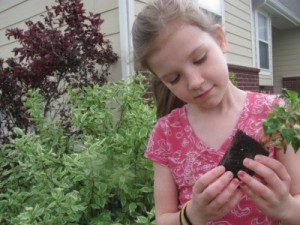My weakness is “fill a flat” sale! I lose all self control! With two of my three in tow, we pulled into my favorite garden center, the parking lot was full, and the check outline was out the door. It’s almost embarrassing to say, my heart started racing and my palms were sweaty, I was giddy with excitement! It’s finally here! I survived an especially long winter and the annuals and perennials were calling my name! We filled my dream car (a minivan) with our flats and headed home.

Now it’s time to roll up my sleeves and get our garden and landscape beds into shape (I’m a little behind. I should have started this a couple of weeks ago)! Who knew “dirt” could be so complex and needy! It is the main ingredient to our gardening success.
Tips for preparing your soil.
1. Soil testing: The most accurate soil tests will come from your local County Extension Service (often listed under state or county government in the phonebook). They will have sample bags, forms, a soil probe and instructions on collecting samples. You can also purchase a soil test kit at the local garden store. The soil kit will provide a quick result and will allow for you to make nutrient management decisions.
2. The results: The soil analysis results make recommendations based on the P and K levels, and nutrient needs of N. You are now ready to complete a balanced nutrient application. Remember, plants are alive and need to be “fed”.
3. Adjust pH: Add lime to the garden if it has a pH of 5.8 or lower. This means it’s acidic. Add iron sulfate, powdered sulfur or aluminum sulfate to the soil if the pH is 7.2 or higher, which means it’s alkaline.
4. Nutrients: Feed the soil with compost and/or commercial fertilizers, which provides the nutrients plants require for growth and health. If you use commercial fertilizer, the three numbers listed on the bag represent the proportion of nitrogen, phosphorous and potassium, three naturally-occurring elements in the environment that are essential for plant growth.
a. N – Plants with adequate nitrogen show healthy vigorous growth, strong root development, dark green foliage, increased seed and fruit formation and higher yields.
b. P – Plants need phosphorus to stimulate root development and flowering, and to help in the prevention of disease and stress.
c. K – Potassium stops plant wilting, strengthens roots and stems, and assists in transferring food.
5. Cultivate: Cultivate the soil by roto tilling (use of a motorized cultivator that works the soil by rotating blades) or hoeing (great exercise!). I like to delegate this one!
6. Dig in: Plant vegetables in groupings according to their fertilizer needs. Plant beans, peas, radishes, watermelons and turnips near each other because they require less fertilizer. Plant cabbage, tomatoes, sweet corn, beets, carrots, onions, celery and potatoes together because they all require more fertilizer.







Very good information. I never really put much thought into where to plant certain vegetables. This makes perfect sense.